Case Study Analysis: Service Delivery Failure and Recovery (MKT203)
VerifiedAdded on 2023/03/30
|8
|1926
|138
Case Study
AI Summary
This case study analyzes a service delivery failure incident that occurred during a flight, where a passenger was physically injured due to a conflict with security personnel. The report examines the roles and responsibilities of the service personnel involved and identifies the type of complaint as a reflexive complaint, attributing the root causes to locus and controllability. The analysis recommends a service recovery strategy that includes apologies, assistance, and compensation to address the incident. Furthermore, the case study proposes strategies for maintaining customer loyalty and retention, such as effective communication and complaint handling. The report emphasizes the importance of training programs and psychological behavior methods to improve customer service and build positive relationships. The conclusion highlights the significance of these strategies in mitigating service failures and enhancing customer satisfaction.
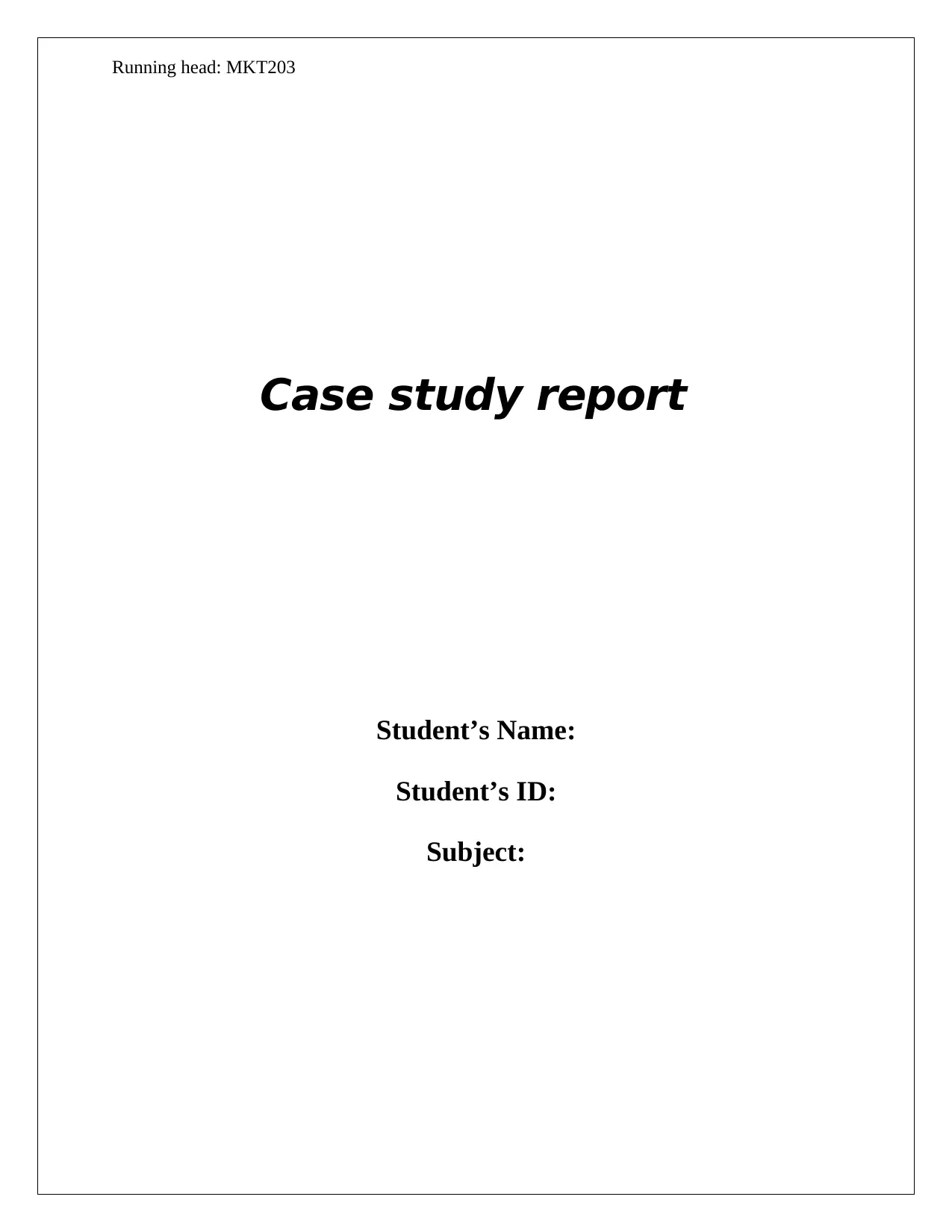
Running head: MKT203
Case study report
Student’s Name:
Student’s ID:
Subject:
Case study report
Student’s Name:
Student’s ID:
Subject:
Paraphrase This Document
Need a fresh take? Get an instant paraphrase of this document with our AI Paraphraser
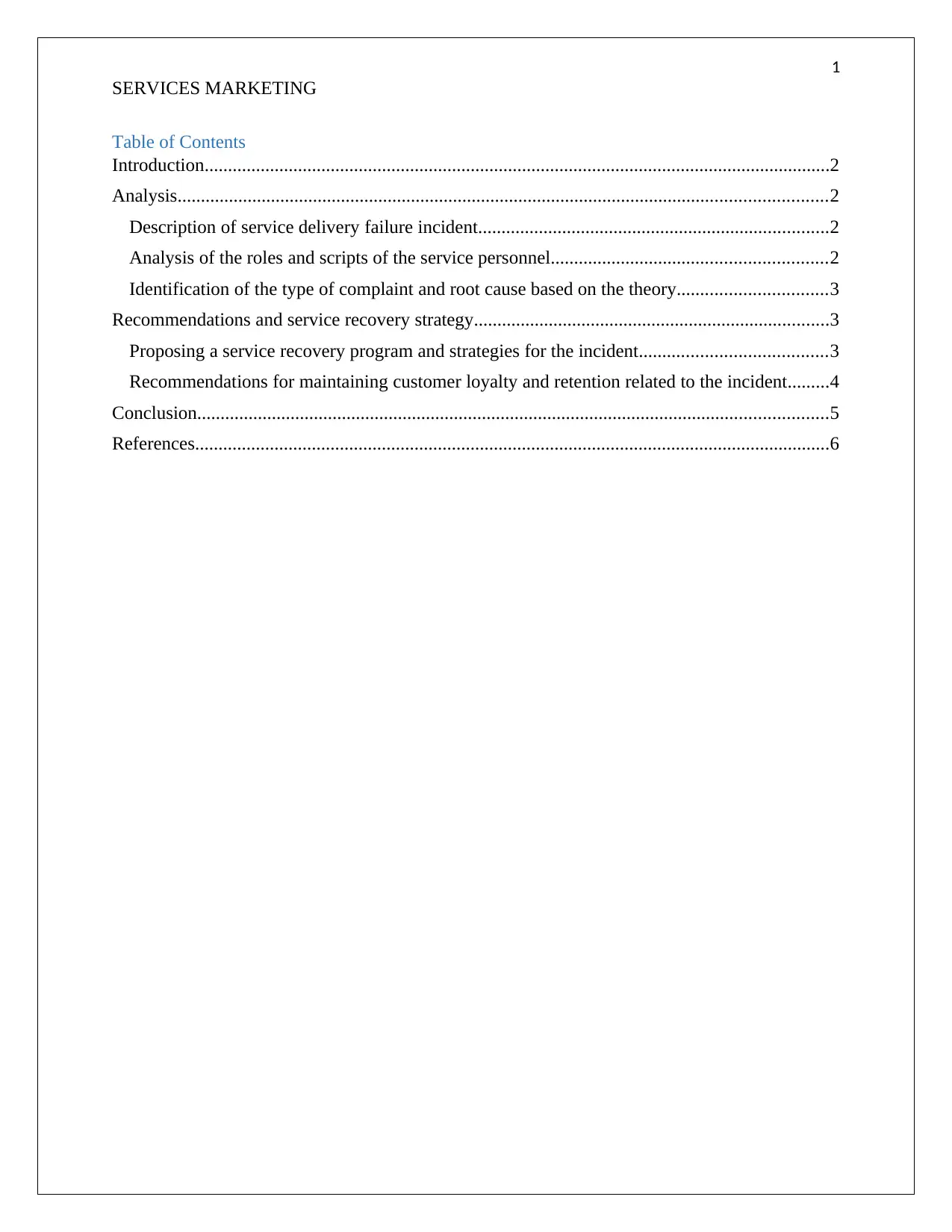
1
SERVICES MARKETING
Table of Contents
Introduction......................................................................................................................................2
Analysis...........................................................................................................................................2
Description of service delivery failure incident...........................................................................2
Analysis of the roles and scripts of the service personnel...........................................................2
Identification of the type of complaint and root cause based on the theory................................3
Recommendations and service recovery strategy............................................................................3
Proposing a service recovery program and strategies for the incident........................................3
Recommendations for maintaining customer loyalty and retention related to the incident.........4
Conclusion.......................................................................................................................................5
References........................................................................................................................................6
SERVICES MARKETING
Table of Contents
Introduction......................................................................................................................................2
Analysis...........................................................................................................................................2
Description of service delivery failure incident...........................................................................2
Analysis of the roles and scripts of the service personnel...........................................................2
Identification of the type of complaint and root cause based on the theory................................3
Recommendations and service recovery strategy............................................................................3
Proposing a service recovery program and strategies for the incident........................................3
Recommendations for maintaining customer loyalty and retention related to the incident.........4
Conclusion.......................................................................................................................................5
References........................................................................................................................................6
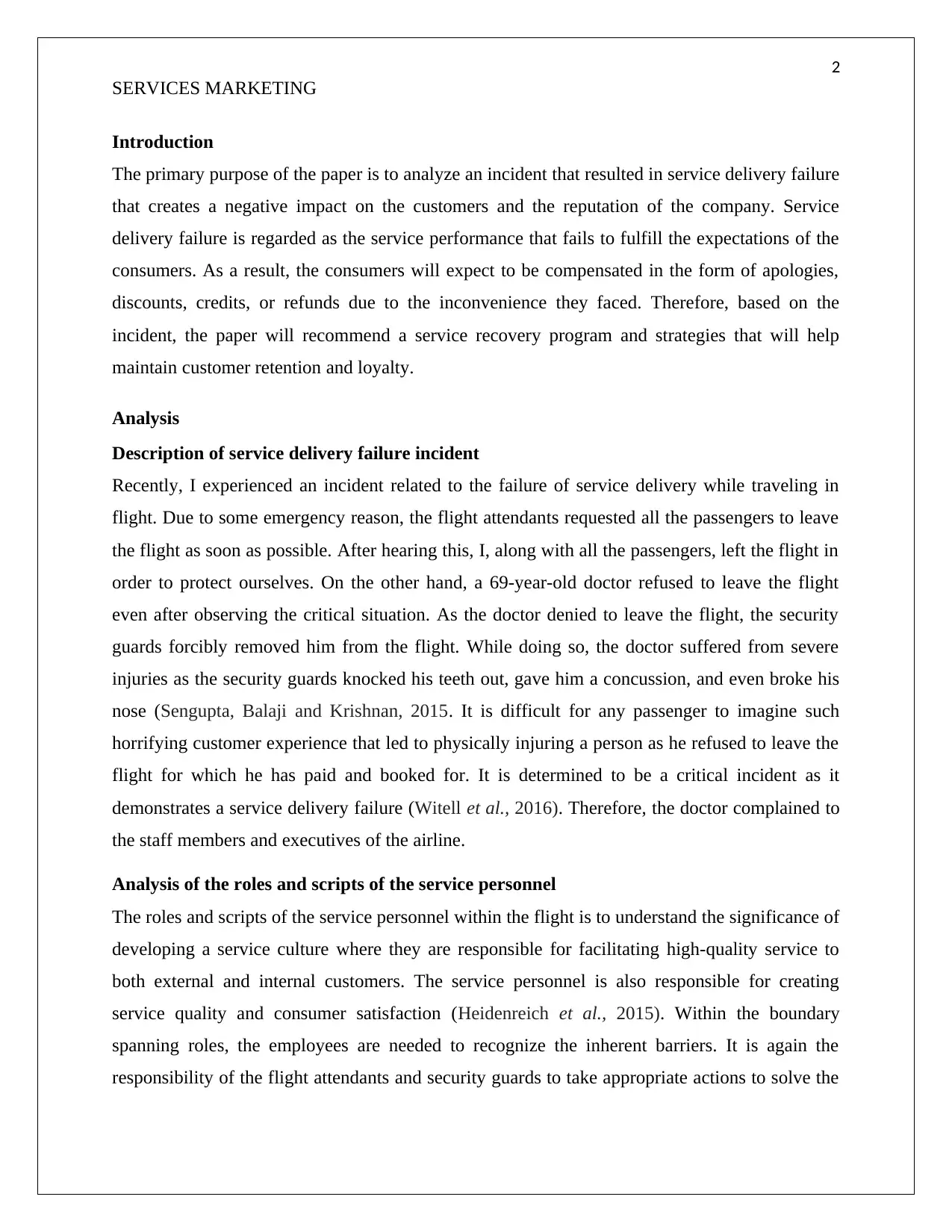
2
SERVICES MARKETING
Introduction
The primary purpose of the paper is to analyze an incident that resulted in service delivery failure
that creates a negative impact on the customers and the reputation of the company. Service
delivery failure is regarded as the service performance that fails to fulfill the expectations of the
consumers. As a result, the consumers will expect to be compensated in the form of apologies,
discounts, credits, or refunds due to the inconvenience they faced. Therefore, based on the
incident, the paper will recommend a service recovery program and strategies that will help
maintain customer retention and loyalty.
Analysis
Description of service delivery failure incident
Recently, I experienced an incident related to the failure of service delivery while traveling in
flight. Due to some emergency reason, the flight attendants requested all the passengers to leave
the flight as soon as possible. After hearing this, I, along with all the passengers, left the flight in
order to protect ourselves. On the other hand, a 69-year-old doctor refused to leave the flight
even after observing the critical situation. As the doctor denied to leave the flight, the security
guards forcibly removed him from the flight. While doing so, the doctor suffered from severe
injuries as the security guards knocked his teeth out, gave him a concussion, and even broke his
nose (Sengupta, Balaji and Krishnan, 2015. It is difficult for any passenger to imagine such
horrifying customer experience that led to physically injuring a person as he refused to leave the
flight for which he has paid and booked for. It is determined to be a critical incident as it
demonstrates a service delivery failure (Witell et al., 2016). Therefore, the doctor complained to
the staff members and executives of the airline.
Analysis of the roles and scripts of the service personnel
The roles and scripts of the service personnel within the flight is to understand the significance of
developing a service culture where they are responsible for facilitating high-quality service to
both external and internal customers. The service personnel is also responsible for creating
service quality and consumer satisfaction (Heidenreich et al., 2015). Within the boundary
spanning roles, the employees are needed to recognize the inherent barriers. It is again the
responsibility of the flight attendants and security guards to take appropriate actions to solve the
SERVICES MARKETING
Introduction
The primary purpose of the paper is to analyze an incident that resulted in service delivery failure
that creates a negative impact on the customers and the reputation of the company. Service
delivery failure is regarded as the service performance that fails to fulfill the expectations of the
consumers. As a result, the consumers will expect to be compensated in the form of apologies,
discounts, credits, or refunds due to the inconvenience they faced. Therefore, based on the
incident, the paper will recommend a service recovery program and strategies that will help
maintain customer retention and loyalty.
Analysis
Description of service delivery failure incident
Recently, I experienced an incident related to the failure of service delivery while traveling in
flight. Due to some emergency reason, the flight attendants requested all the passengers to leave
the flight as soon as possible. After hearing this, I, along with all the passengers, left the flight in
order to protect ourselves. On the other hand, a 69-year-old doctor refused to leave the flight
even after observing the critical situation. As the doctor denied to leave the flight, the security
guards forcibly removed him from the flight. While doing so, the doctor suffered from severe
injuries as the security guards knocked his teeth out, gave him a concussion, and even broke his
nose (Sengupta, Balaji and Krishnan, 2015. It is difficult for any passenger to imagine such
horrifying customer experience that led to physically injuring a person as he refused to leave the
flight for which he has paid and booked for. It is determined to be a critical incident as it
demonstrates a service delivery failure (Witell et al., 2016). Therefore, the doctor complained to
the staff members and executives of the airline.
Analysis of the roles and scripts of the service personnel
The roles and scripts of the service personnel within the flight is to understand the significance of
developing a service culture where they are responsible for facilitating high-quality service to
both external and internal customers. The service personnel is also responsible for creating
service quality and consumer satisfaction (Heidenreich et al., 2015). Within the boundary
spanning roles, the employees are needed to recognize the inherent barriers. It is again the
responsibility of the flight attendants and security guards to take appropriate actions to solve the
⊘ This is a preview!⊘
Do you want full access?
Subscribe today to unlock all pages.

Trusted by 1+ million students worldwide
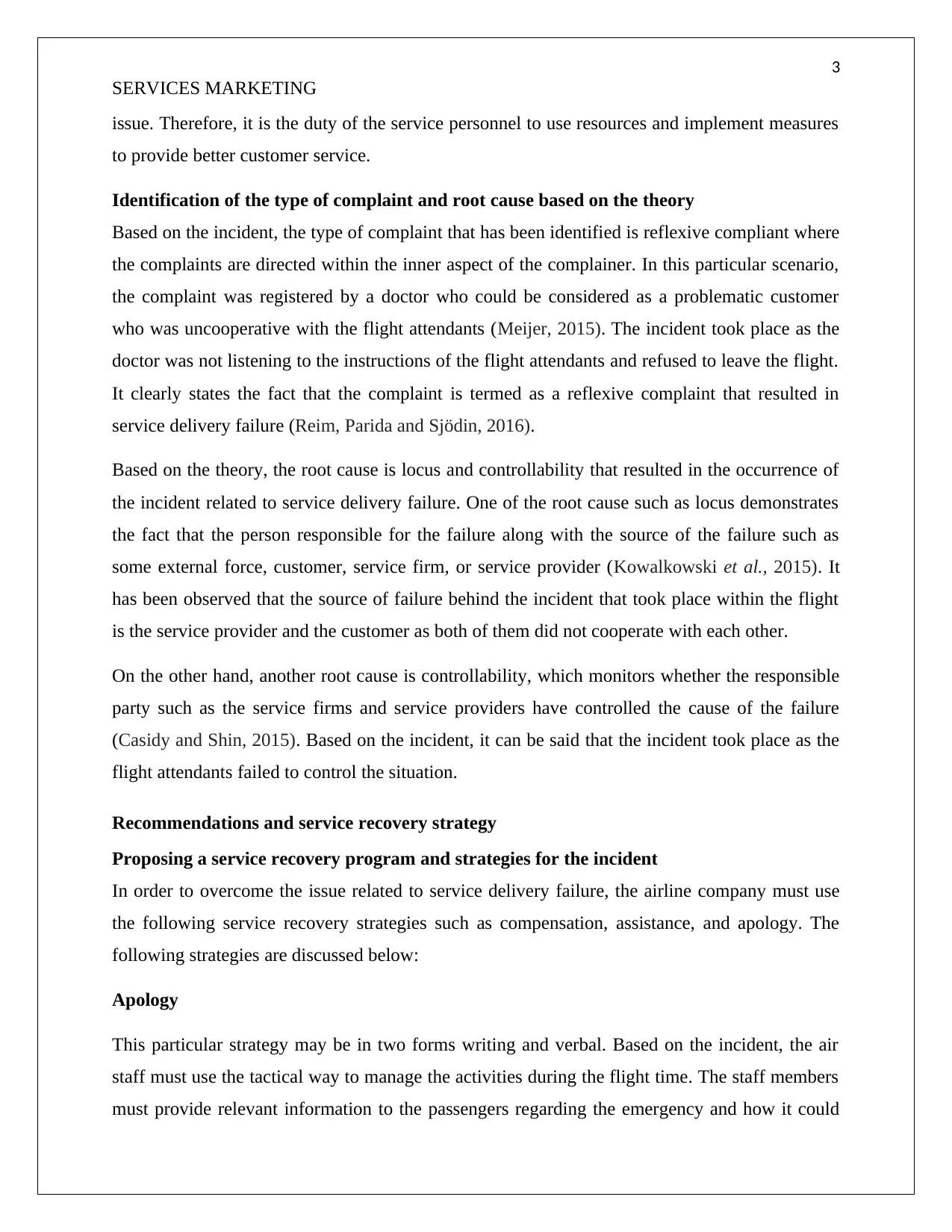
3
SERVICES MARKETING
issue. Therefore, it is the duty of the service personnel to use resources and implement measures
to provide better customer service.
Identification of the type of complaint and root cause based on the theory
Based on the incident, the type of complaint that has been identified is reflexive compliant where
the complaints are directed within the inner aspect of the complainer. In this particular scenario,
the complaint was registered by a doctor who could be considered as a problematic customer
who was uncooperative with the flight attendants (Meijer, 2015). The incident took place as the
doctor was not listening to the instructions of the flight attendants and refused to leave the flight.
It clearly states the fact that the complaint is termed as a reflexive complaint that resulted in
service delivery failure (Reim, Parida and Sjödin, 2016).
Based on the theory, the root cause is locus and controllability that resulted in the occurrence of
the incident related to service delivery failure. One of the root cause such as locus demonstrates
the fact that the person responsible for the failure along with the source of the failure such as
some external force, customer, service firm, or service provider (Kowalkowski et al., 2015). It
has been observed that the source of failure behind the incident that took place within the flight
is the service provider and the customer as both of them did not cooperate with each other.
On the other hand, another root cause is controllability, which monitors whether the responsible
party such as the service firms and service providers have controlled the cause of the failure
(Casidy and Shin, 2015). Based on the incident, it can be said that the incident took place as the
flight attendants failed to control the situation.
Recommendations and service recovery strategy
Proposing a service recovery program and strategies for the incident
In order to overcome the issue related to service delivery failure, the airline company must use
the following service recovery strategies such as compensation, assistance, and apology. The
following strategies are discussed below:
Apology
This particular strategy may be in two forms writing and verbal. Based on the incident, the air
staff must use the tactical way to manage the activities during the flight time. The staff members
must provide relevant information to the passengers regarding the emergency and how it could
SERVICES MARKETING
issue. Therefore, it is the duty of the service personnel to use resources and implement measures
to provide better customer service.
Identification of the type of complaint and root cause based on the theory
Based on the incident, the type of complaint that has been identified is reflexive compliant where
the complaints are directed within the inner aspect of the complainer. In this particular scenario,
the complaint was registered by a doctor who could be considered as a problematic customer
who was uncooperative with the flight attendants (Meijer, 2015). The incident took place as the
doctor was not listening to the instructions of the flight attendants and refused to leave the flight.
It clearly states the fact that the complaint is termed as a reflexive complaint that resulted in
service delivery failure (Reim, Parida and Sjödin, 2016).
Based on the theory, the root cause is locus and controllability that resulted in the occurrence of
the incident related to service delivery failure. One of the root cause such as locus demonstrates
the fact that the person responsible for the failure along with the source of the failure such as
some external force, customer, service firm, or service provider (Kowalkowski et al., 2015). It
has been observed that the source of failure behind the incident that took place within the flight
is the service provider and the customer as both of them did not cooperate with each other.
On the other hand, another root cause is controllability, which monitors whether the responsible
party such as the service firms and service providers have controlled the cause of the failure
(Casidy and Shin, 2015). Based on the incident, it can be said that the incident took place as the
flight attendants failed to control the situation.
Recommendations and service recovery strategy
Proposing a service recovery program and strategies for the incident
In order to overcome the issue related to service delivery failure, the airline company must use
the following service recovery strategies such as compensation, assistance, and apology. The
following strategies are discussed below:
Apology
This particular strategy may be in two forms writing and verbal. Based on the incident, the air
staff must use the tactical way to manage the activities during the flight time. The staff members
must provide relevant information to the passengers regarding the emergency and how it could
Paraphrase This Document
Need a fresh take? Get an instant paraphrase of this document with our AI Paraphraser
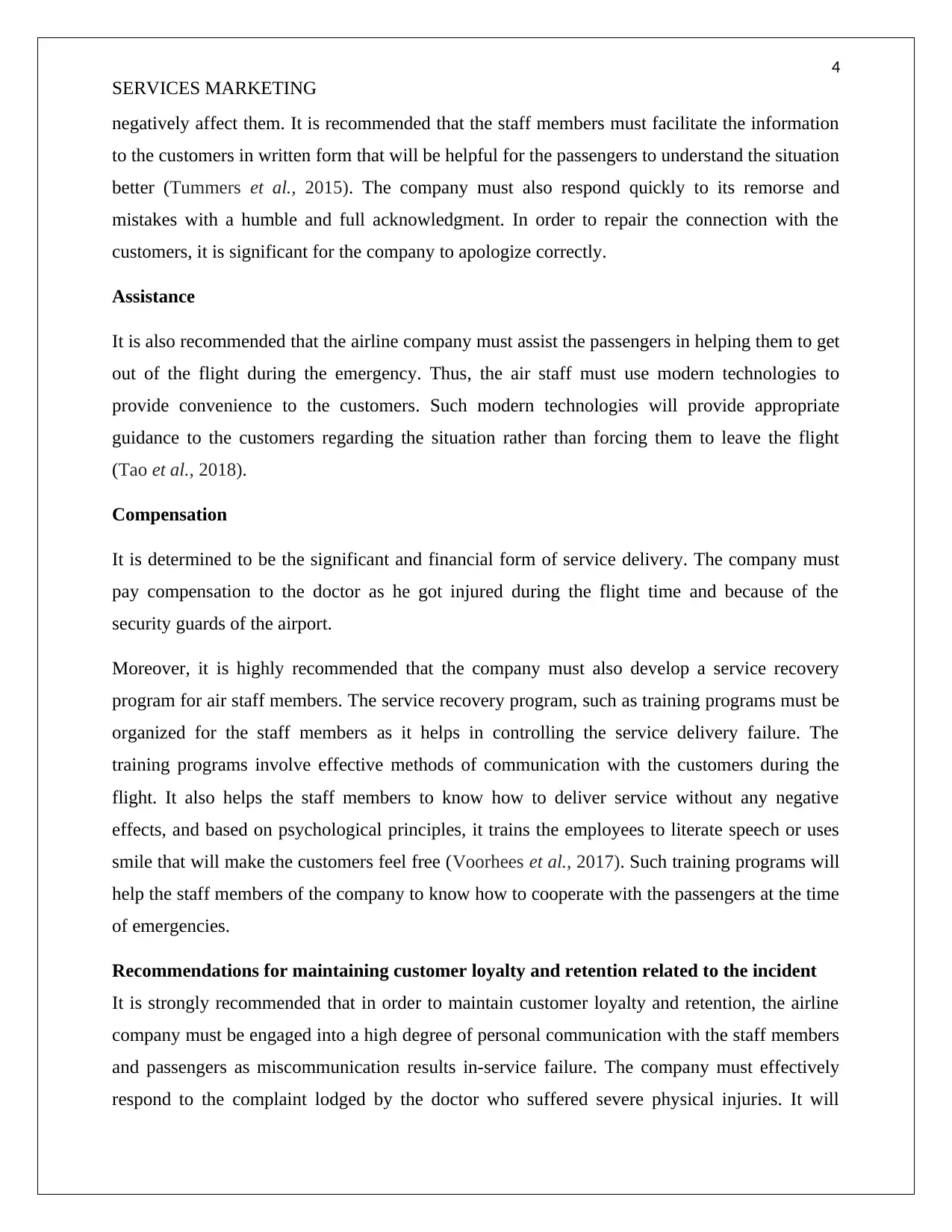
4
SERVICES MARKETING
negatively affect them. It is recommended that the staff members must facilitate the information
to the customers in written form that will be helpful for the passengers to understand the situation
better (Tummers et al., 2015). The company must also respond quickly to its remorse and
mistakes with a humble and full acknowledgment. In order to repair the connection with the
customers, it is significant for the company to apologize correctly.
Assistance
It is also recommended that the airline company must assist the passengers in helping them to get
out of the flight during the emergency. Thus, the air staff must use modern technologies to
provide convenience to the customers. Such modern technologies will provide appropriate
guidance to the customers regarding the situation rather than forcing them to leave the flight
(Tao et al., 2018).
Compensation
It is determined to be the significant and financial form of service delivery. The company must
pay compensation to the doctor as he got injured during the flight time and because of the
security guards of the airport.
Moreover, it is highly recommended that the company must also develop a service recovery
program for air staff members. The service recovery program, such as training programs must be
organized for the staff members as it helps in controlling the service delivery failure. The
training programs involve effective methods of communication with the customers during the
flight. It also helps the staff members to know how to deliver service without any negative
effects, and based on psychological principles, it trains the employees to literate speech or uses
smile that will make the customers feel free (Voorhees et al., 2017). Such training programs will
help the staff members of the company to know how to cooperate with the passengers at the time
of emergencies.
Recommendations for maintaining customer loyalty and retention related to the incident
It is strongly recommended that in order to maintain customer loyalty and retention, the airline
company must be engaged into a high degree of personal communication with the staff members
and passengers as miscommunication results in-service failure. The company must effectively
respond to the complaint lodged by the doctor who suffered severe physical injuries. It will
SERVICES MARKETING
negatively affect them. It is recommended that the staff members must facilitate the information
to the customers in written form that will be helpful for the passengers to understand the situation
better (Tummers et al., 2015). The company must also respond quickly to its remorse and
mistakes with a humble and full acknowledgment. In order to repair the connection with the
customers, it is significant for the company to apologize correctly.
Assistance
It is also recommended that the airline company must assist the passengers in helping them to get
out of the flight during the emergency. Thus, the air staff must use modern technologies to
provide convenience to the customers. Such modern technologies will provide appropriate
guidance to the customers regarding the situation rather than forcing them to leave the flight
(Tao et al., 2018).
Compensation
It is determined to be the significant and financial form of service delivery. The company must
pay compensation to the doctor as he got injured during the flight time and because of the
security guards of the airport.
Moreover, it is highly recommended that the company must also develop a service recovery
program for air staff members. The service recovery program, such as training programs must be
organized for the staff members as it helps in controlling the service delivery failure. The
training programs involve effective methods of communication with the customers during the
flight. It also helps the staff members to know how to deliver service without any negative
effects, and based on psychological principles, it trains the employees to literate speech or uses
smile that will make the customers feel free (Voorhees et al., 2017). Such training programs will
help the staff members of the company to know how to cooperate with the passengers at the time
of emergencies.
Recommendations for maintaining customer loyalty and retention related to the incident
It is strongly recommended that in order to maintain customer loyalty and retention, the airline
company must be engaged into a high degree of personal communication with the staff members
and passengers as miscommunication results in-service failure. The company must effectively
respond to the complaint lodged by the doctor who suffered severe physical injuries. It will
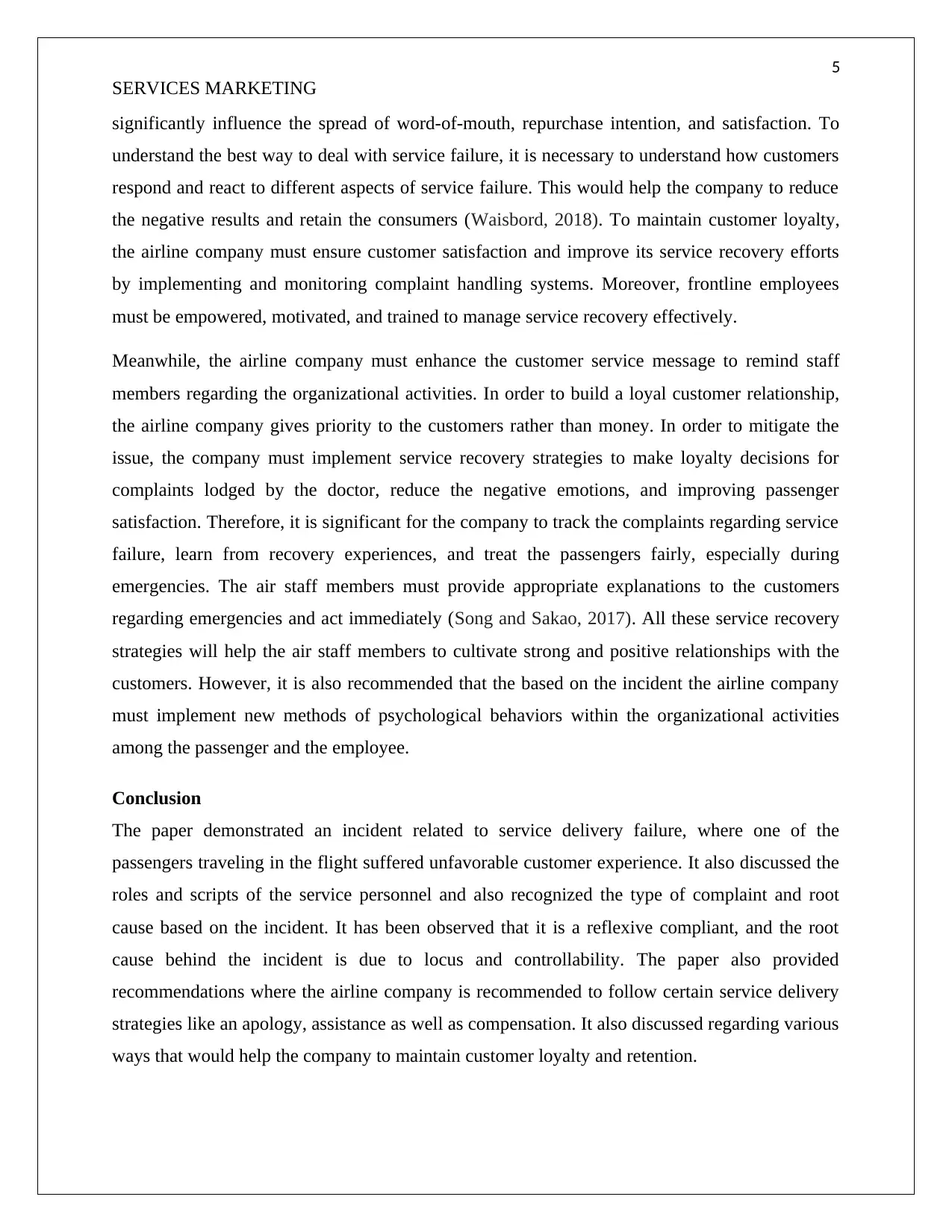
5
SERVICES MARKETING
significantly influence the spread of word-of-mouth, repurchase intention, and satisfaction. To
understand the best way to deal with service failure, it is necessary to understand how customers
respond and react to different aspects of service failure. This would help the company to reduce
the negative results and retain the consumers (Waisbord, 2018). To maintain customer loyalty,
the airline company must ensure customer satisfaction and improve its service recovery efforts
by implementing and monitoring complaint handling systems. Moreover, frontline employees
must be empowered, motivated, and trained to manage service recovery effectively.
Meanwhile, the airline company must enhance the customer service message to remind staff
members regarding the organizational activities. In order to build a loyal customer relationship,
the airline company gives priority to the customers rather than money. In order to mitigate the
issue, the company must implement service recovery strategies to make loyalty decisions for
complaints lodged by the doctor, reduce the negative emotions, and improving passenger
satisfaction. Therefore, it is significant for the company to track the complaints regarding service
failure, learn from recovery experiences, and treat the passengers fairly, especially during
emergencies. The air staff members must provide appropriate explanations to the customers
regarding emergencies and act immediately (Song and Sakao, 2017). All these service recovery
strategies will help the air staff members to cultivate strong and positive relationships with the
customers. However, it is also recommended that the based on the incident the airline company
must implement new methods of psychological behaviors within the organizational activities
among the passenger and the employee.
Conclusion
The paper demonstrated an incident related to service delivery failure, where one of the
passengers traveling in the flight suffered unfavorable customer experience. It also discussed the
roles and scripts of the service personnel and also recognized the type of complaint and root
cause based on the incident. It has been observed that it is a reflexive compliant, and the root
cause behind the incident is due to locus and controllability. The paper also provided
recommendations where the airline company is recommended to follow certain service delivery
strategies like an apology, assistance as well as compensation. It also discussed regarding various
ways that would help the company to maintain customer loyalty and retention.
SERVICES MARKETING
significantly influence the spread of word-of-mouth, repurchase intention, and satisfaction. To
understand the best way to deal with service failure, it is necessary to understand how customers
respond and react to different aspects of service failure. This would help the company to reduce
the negative results and retain the consumers (Waisbord, 2018). To maintain customer loyalty,
the airline company must ensure customer satisfaction and improve its service recovery efforts
by implementing and monitoring complaint handling systems. Moreover, frontline employees
must be empowered, motivated, and trained to manage service recovery effectively.
Meanwhile, the airline company must enhance the customer service message to remind staff
members regarding the organizational activities. In order to build a loyal customer relationship,
the airline company gives priority to the customers rather than money. In order to mitigate the
issue, the company must implement service recovery strategies to make loyalty decisions for
complaints lodged by the doctor, reduce the negative emotions, and improving passenger
satisfaction. Therefore, it is significant for the company to track the complaints regarding service
failure, learn from recovery experiences, and treat the passengers fairly, especially during
emergencies. The air staff members must provide appropriate explanations to the customers
regarding emergencies and act immediately (Song and Sakao, 2017). All these service recovery
strategies will help the air staff members to cultivate strong and positive relationships with the
customers. However, it is also recommended that the based on the incident the airline company
must implement new methods of psychological behaviors within the organizational activities
among the passenger and the employee.
Conclusion
The paper demonstrated an incident related to service delivery failure, where one of the
passengers traveling in the flight suffered unfavorable customer experience. It also discussed the
roles and scripts of the service personnel and also recognized the type of complaint and root
cause based on the incident. It has been observed that it is a reflexive compliant, and the root
cause behind the incident is due to locus and controllability. The paper also provided
recommendations where the airline company is recommended to follow certain service delivery
strategies like an apology, assistance as well as compensation. It also discussed regarding various
ways that would help the company to maintain customer loyalty and retention.
⊘ This is a preview!⊘
Do you want full access?
Subscribe today to unlock all pages.

Trusted by 1+ million students worldwide
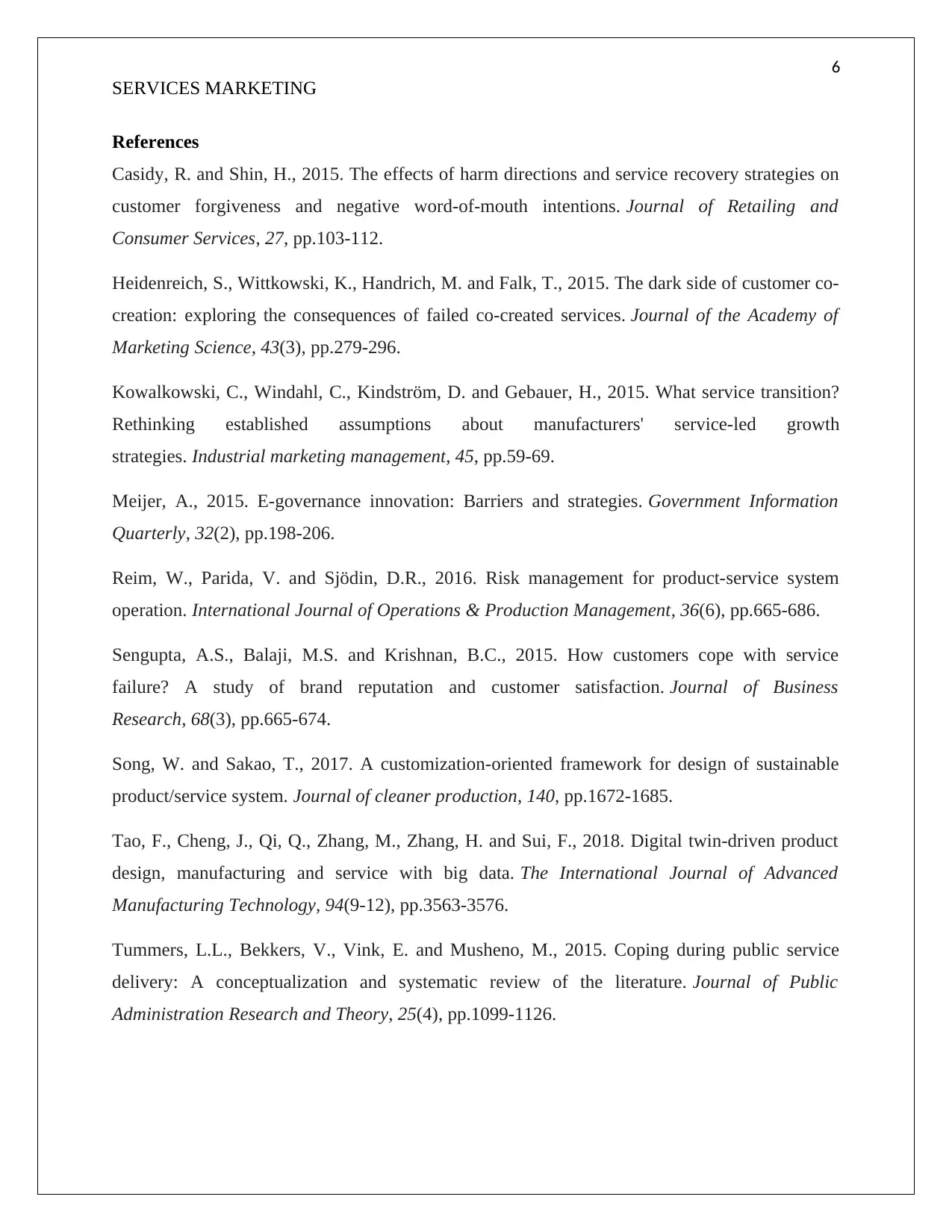
6
SERVICES MARKETING
References
Casidy, R. and Shin, H., 2015. The effects of harm directions and service recovery strategies on
customer forgiveness and negative word-of-mouth intentions. Journal of Retailing and
Consumer Services, 27, pp.103-112.
Heidenreich, S., Wittkowski, K., Handrich, M. and Falk, T., 2015. The dark side of customer co-
creation: exploring the consequences of failed co-created services. Journal of the Academy of
Marketing Science, 43(3), pp.279-296.
Kowalkowski, C., Windahl, C., Kindström, D. and Gebauer, H., 2015. What service transition?
Rethinking established assumptions about manufacturers' service-led growth
strategies. Industrial marketing management, 45, pp.59-69.
Meijer, A., 2015. E-governance innovation: Barriers and strategies. Government Information
Quarterly, 32(2), pp.198-206.
Reim, W., Parida, V. and Sjödin, D.R., 2016. Risk management for product-service system
operation. International Journal of Operations & Production Management, 36(6), pp.665-686.
Sengupta, A.S., Balaji, M.S. and Krishnan, B.C., 2015. How customers cope with service
failure? A study of brand reputation and customer satisfaction. Journal of Business
Research, 68(3), pp.665-674.
Song, W. and Sakao, T., 2017. A customization-oriented framework for design of sustainable
product/service system. Journal of cleaner production, 140, pp.1672-1685.
Tao, F., Cheng, J., Qi, Q., Zhang, M., Zhang, H. and Sui, F., 2018. Digital twin-driven product
design, manufacturing and service with big data. The International Journal of Advanced
Manufacturing Technology, 94(9-12), pp.3563-3576.
Tummers, L.L., Bekkers, V., Vink, E. and Musheno, M., 2015. Coping during public service
delivery: A conceptualization and systematic review of the literature. Journal of Public
Administration Research and Theory, 25(4), pp.1099-1126.
SERVICES MARKETING
References
Casidy, R. and Shin, H., 2015. The effects of harm directions and service recovery strategies on
customer forgiveness and negative word-of-mouth intentions. Journal of Retailing and
Consumer Services, 27, pp.103-112.
Heidenreich, S., Wittkowski, K., Handrich, M. and Falk, T., 2015. The dark side of customer co-
creation: exploring the consequences of failed co-created services. Journal of the Academy of
Marketing Science, 43(3), pp.279-296.
Kowalkowski, C., Windahl, C., Kindström, D. and Gebauer, H., 2015. What service transition?
Rethinking established assumptions about manufacturers' service-led growth
strategies. Industrial marketing management, 45, pp.59-69.
Meijer, A., 2015. E-governance innovation: Barriers and strategies. Government Information
Quarterly, 32(2), pp.198-206.
Reim, W., Parida, V. and Sjödin, D.R., 2016. Risk management for product-service system
operation. International Journal of Operations & Production Management, 36(6), pp.665-686.
Sengupta, A.S., Balaji, M.S. and Krishnan, B.C., 2015. How customers cope with service
failure? A study of brand reputation and customer satisfaction. Journal of Business
Research, 68(3), pp.665-674.
Song, W. and Sakao, T., 2017. A customization-oriented framework for design of sustainable
product/service system. Journal of cleaner production, 140, pp.1672-1685.
Tao, F., Cheng, J., Qi, Q., Zhang, M., Zhang, H. and Sui, F., 2018. Digital twin-driven product
design, manufacturing and service with big data. The International Journal of Advanced
Manufacturing Technology, 94(9-12), pp.3563-3576.
Tummers, L.L., Bekkers, V., Vink, E. and Musheno, M., 2015. Coping during public service
delivery: A conceptualization and systematic review of the literature. Journal of Public
Administration Research and Theory, 25(4), pp.1099-1126.
Paraphrase This Document
Need a fresh take? Get an instant paraphrase of this document with our AI Paraphraser
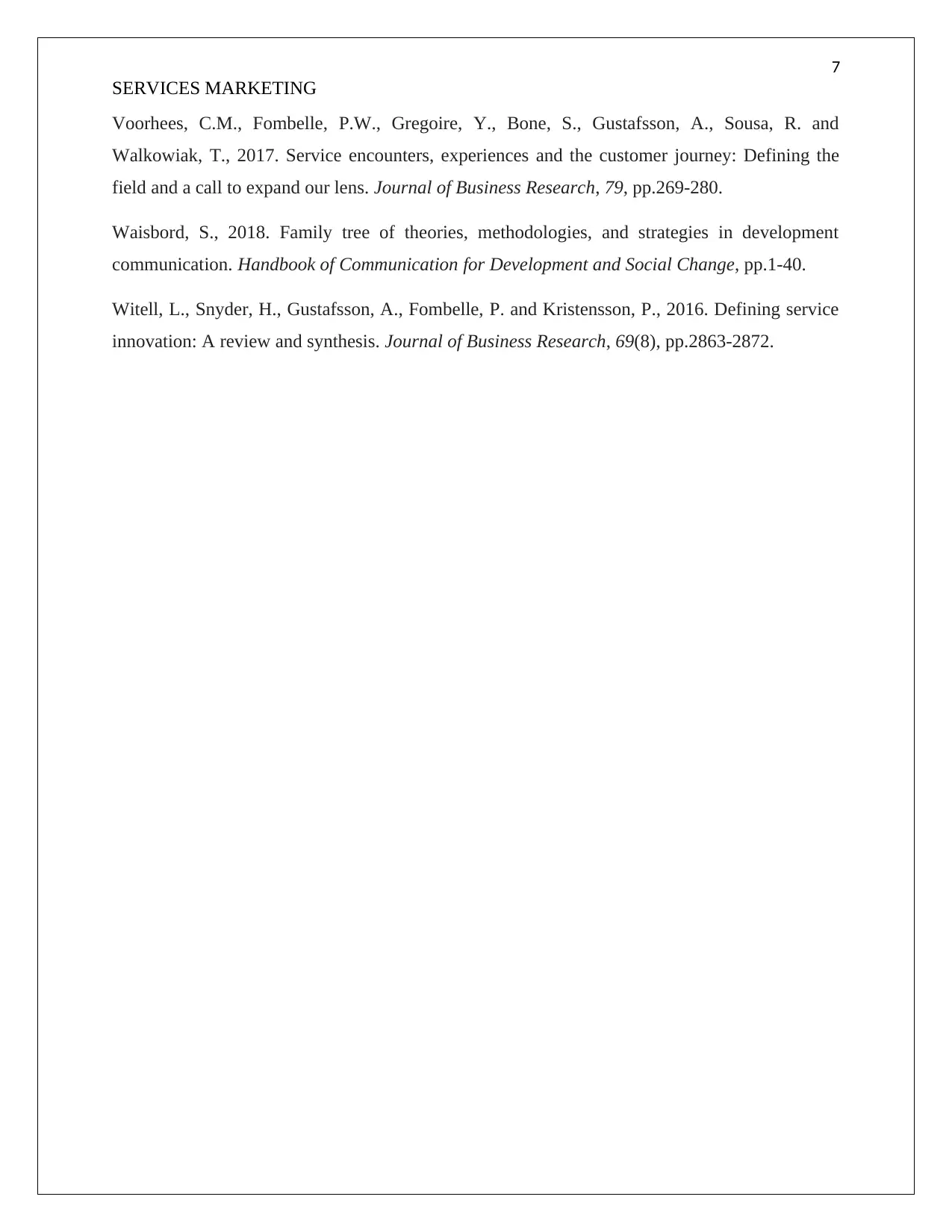
7
SERVICES MARKETING
Voorhees, C.M., Fombelle, P.W., Gregoire, Y., Bone, S., Gustafsson, A., Sousa, R. and
Walkowiak, T., 2017. Service encounters, experiences and the customer journey: Defining the
field and a call to expand our lens. Journal of Business Research, 79, pp.269-280.
Waisbord, S., 2018. Family tree of theories, methodologies, and strategies in development
communication. Handbook of Communication for Development and Social Change, pp.1-40.
Witell, L., Snyder, H., Gustafsson, A., Fombelle, P. and Kristensson, P., 2016. Defining service
innovation: A review and synthesis. Journal of Business Research, 69(8), pp.2863-2872.
SERVICES MARKETING
Voorhees, C.M., Fombelle, P.W., Gregoire, Y., Bone, S., Gustafsson, A., Sousa, R. and
Walkowiak, T., 2017. Service encounters, experiences and the customer journey: Defining the
field and a call to expand our lens. Journal of Business Research, 79, pp.269-280.
Waisbord, S., 2018. Family tree of theories, methodologies, and strategies in development
communication. Handbook of Communication for Development and Social Change, pp.1-40.
Witell, L., Snyder, H., Gustafsson, A., Fombelle, P. and Kristensson, P., 2016. Defining service
innovation: A review and synthesis. Journal of Business Research, 69(8), pp.2863-2872.
1 out of 8
Related Documents
Your All-in-One AI-Powered Toolkit for Academic Success.
+13062052269
info@desklib.com
Available 24*7 on WhatsApp / Email
![[object Object]](/_next/static/media/star-bottom.7253800d.svg)
Unlock your academic potential
Copyright © 2020–2025 A2Z Services. All Rights Reserved. Developed and managed by ZUCOL.




